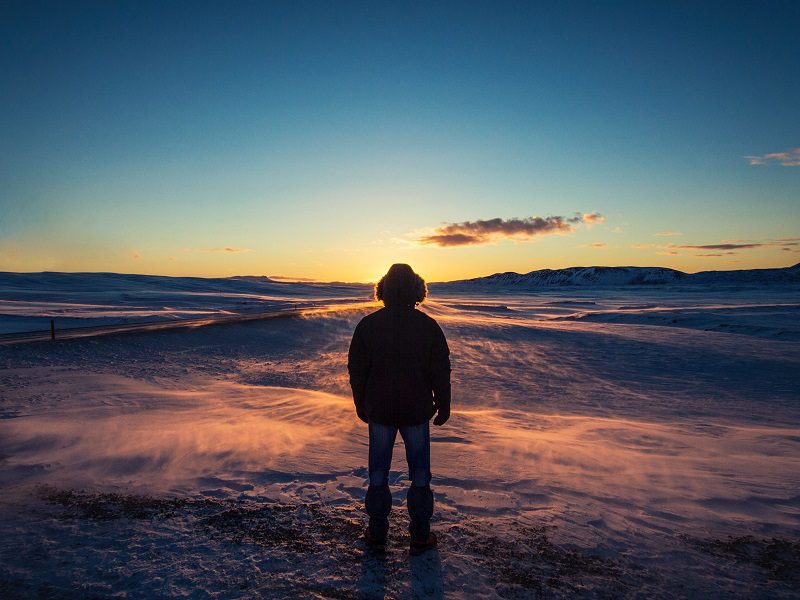Visiting Iceland in winter is an adventure on its own. Northern lights, snowy mountains, and waterfalls covered with icicled – a true winter wonderland. There is plenty to see and do, and generally, it is a lot cheaper to travel to Iceland outside the summer months. So, where is the catch, you might ask? Well, the biggest cons are the short days and the weather. But how dark and how cold does it get in Iceland? Well, in my experience, many travelers who visited Iceland in winter said they thought it would be a lot colder. Of course, Icelandic weather is unpredictable. We can’t foresee everything; for example, this year, winter decided to come earlier than usual, causing some road closures (including parts of the Ring Road) due to snowy and slippery conditions when winter tires are still not allowed. However, we can take a look at some statistical data and talk about the average weather to give you a better understanding of how dark and how cold winters are in Iceland.

How Long is Winter in Iceland?
Some would say winter in Iceland lasts 12 months because Iceland has only two seasons – winter and mild winter. In truth, when we talk about winter in Iceland, we usually have in mind November through March, sometimes October and April, depending on the weather that year. You will probably notice me saying “it depends” a lot throughout this blog post. Unfortunately, as I already mentioned, the weather in Iceland is unpredictable, and it may vary from year to year. Sometimes we have very mild winters when I could spend most of the time walking around in sneakers, and some years it gets colder, or wetter, or both.
How Cold is in Iceland?
As I said, many visitors get pleasantly surprised it’s not that cold! The average temperature throughout winter lingers around 0°C (32°F), considering the average temperature in summer is about 8-13°C (46-55°F) it is not that bad, right?
| October | November | December | January | February | March | April |
+2 – +7°C
36 – 44°F | -1 – +3°C
30 – 38°F | -3 – +2°C
27 – 35° F | -3 – +2°C
27 – 35° F | -3 – +3°C
26 – 37° F | -2 – +3°C
28 – 38° F | +1 – 7°C
34 – 45° F |
Average temperatures in Iceland in winterKeep in mind, these are just average temperatures. There are a lot of factors that can come into play, such as your location. South, South-West parts tend to stay warmer, meanwhile up in the North and in high areas temperatures are lower. It could go as low as -30°C (-22°F) but generally stay slightly below 0°C (32°F).
While winters may not be as cold, it is important to remember Iceland is very windy. After all, it is a small island in the middle of the Atlantic Ocean. The wind is what can make the weather in Iceland in winter (or any time of year, to be honest) unbearable. Therefore, make sure to pack rainproof and windproof clothes – jackets, pants, gloves, hats, and so on. Layers, layers, layers! What you can safely leave at home is an umbrella – utterly useless in Iceland, unless you want to try to reach mainland Europe as Mary Poppins (not recommended form of transport). Most likely, it will get broken on the first attempt to open it on a windy day.
How Dark Does it Get?
In the summertime, thousands of tourists come to Iceland to enjoy endless days because the sun stays above the horizon for approximately 21 hours. The main advantage of long days is the ability to travel a lot and see many places in one day. Long nights also have some advantages. The main winter attraction is hunting for northern lights. The longer the nights, the better chance you have to spot them. Also, more and more people, especially those who live in big cities, come to Iceland to experience darkness, spend time stargazing in the middle of nowhere.
The darkest time of the year is the end of December. However, Holidays in Iceland, especially New Year’s Eve in Reykjavik, is a fantastic experience – highly recommend. Below are the average daylight hours during each winter month:
| October | November | December | January | February | March | April |
| 8-11 hours | ±8 hours | 4-5 hours | 5-7 hours | 7-10 hours | 10-13 hours | 13-16 hours |
During the winter months, I wouldn’t squeeze too many stops into my itinerary. I always say quality over quantity – pick top places you want to visit and don’t try to visit EVERYTHING. It’s impossible, even in the summertime.
How Much Does It Snow or Rain in Iceland in Winter?
I’m glad you asked. You can expect heavy rains any time of year (I already mentioned the importance of bringing weatherproof clothes). However, some months are rainier than others, although it is all too unpredictable. When it comes to rain or snow, my personal motto is “be prepared for the worst, but expect the best.”
 Reykjavik
Reykjavik Akureyri
AkureyriThe amount of rainfall varies between locations (above, you can compare Reykjavik and Akureyri). However, these charts can be misleading. Even if you come in May, you may find yourself in a major storm. But, generally, there is more precipitation in the winter months. Again, make sure to pack the right clothes and come well prepared.
Further Reading: Happy Campers Winter Guide
We could spend many hours analyzing different data, but the bottom line is Icelandic weather is unpredictable. Traveling in winter can be more challenging and get you out of your comfort zone. If you want to learn more about traveling to Iceland in winter, I highly recommend checking out our Winter Camping Guide.
If you want to learn more about why you should choose Happy Campers for your winter adventure, click here.
Back